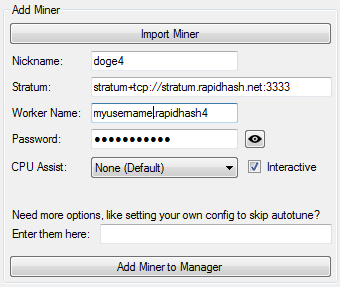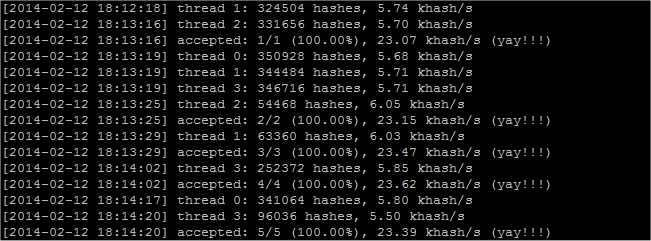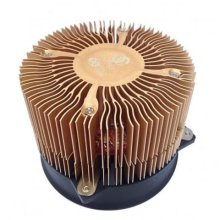How to Mine Dogecoin – a Beginner’s Guide

Image credit: Ð is for Ðogecoin by ZimoNitrome
It’s a currency based on an Internet dog meme.
Obviously it’s the greatest thing ever, so how do you go about mining some of your own Dogecoins?
For those unfamiliar with similar currencies like Bitcoin or Litecoin, there can be a dizzying amount of concepts and terminology to take in.
Here we’ll show you the basics of what you need to start mining DOGE yourself, hopefully without getting lost in the jargon.
Dogecoin has only been in existence since December 2013, but it’s already effectively the 3rd most popular so-called cryptocurrency after Bitcoin and Litecoin (in terms of volume of transactions).
While Internet memes typically have a limited lifespan, there are also some technical reasons to believe that Dogecoin can succeed in the long term.
Not least of these is the fact that Dogecoin will keep adding new coins each year at a steady rate, unlike Bitcoin where there is a limited supply.
Also, there are many more Dogecoins in circulation right now. While this means that each coin has a very small value, it also makes it psychologically much easier to use, since it’s more satisfying and understandable to buy something for a few hundred Dogecoins, instead of perhaps a fraction of a single Bitcoin (even considering smaller Bitcoin denominations such as mBTC).
(See also Tuxedage’s post – A serious Analysis of Dogecoin — Or: Why I am all-in on dogecoin)
What you’ll need to start mining
Ideally – cheap electricity and a bunch of graphics cards.
However, you can start mining Dogecoins even using a single PC. You can also mine without using a graphics card, although the progress will be slower. Mining for coins shouldn’t affect the performance of your computer on the default settings, since it will only use computing or graphics power when the system is idle.
Mining for coins on a laptop is usually not worth it, since it’s not powered on 24/7, the CPU/GPU power is lower, and there is a greater chance of stressing out the chips on the laptop since they’re usually packed into a tighter space, and consequently at more risk of overheating. But if you just want to mine a little bit to get a few coins to play around with, it can do the job.
Compare your setup
If you’re just mining Doge for fun, you might want to skip this bit, but you might be curious about how well your hardware setup is going to work.
The Litecoin Mining Hardware comparision page is what you want.
Since Dogecoin is based on Litecoin, the values here are a good indication of the relative power of your hardware.
Find your graphics card or CPU model in the first column, then check the next column for the kH/s value.
This is a measure of the speed at which you can complete hashes. You’ll probably want something that can do at least 150 – 200 kH/s to mine a decent number of coins, although, the faster cards will consume more electricity, so they may not always be a better option than a slower, more power efficient setup. We give some efficient card recommendations further down.
Update – State of the Doge – Spring 2015
Dogecoin is now a little over a year old, and a lot has happened in that time, far too much to list here!
But in terms of mining Dogecoin, there have been some major changes. Some of the most important have been:
- The rise of Scrypt ASICs – Dogecoin was initially made using the “Scrypt” algorithm which meant that it couldn’t be mined using the specialised hardware ASIC chips that had been designed to more efficiently mine Bitcoin. However this situation didn’t last very long, and about halfway through 2014, ASICs that could mine Scrypt-based coins started to become widespread. This meant that CPU and GPU miners had to compete against the much more energy efficient ASIC miners.
- Merged-mining support was added – There were concerns that one or two big groups were dominating the Dogecoin mining scene, which led to the hypothetical possibility of a 51% attack, where a single group could corrupt the transaction network or blockchain, by virtue of controlling more than half of the processing power (hashrate).
To solve this problem, the Dogecoin developers added AuxPoW support – referring to the fact that now the “PoW” or proof-of-work done by miners of other coins would be accepted in certain circumstances.
The net effect of this was that these other miners now got some Dogecoin at times, and the overall mining difficulty (and hashrate) of the Dogecoin network went up dramatically, thereby spreading out the hashrate over a more diverse mining group, and making mining Dogecoin directly more difficult. - The amount of coins being added to supply decreased – Unlike other coins, there will always be new Dogecoins available for miners to discover, however the number of coins per reward “block” continued decreasing throughout 2014. This was a result of the natural halvening reward schedule for Dogecoin, and was entirely expected, but still put pressure on miners.
However, this addresses some of the initial criticism of Dogecoin where some people commented on the high inflation rate due to the large additional supply of coins per miner block reward. In fact, Dogecoin now has a lower inflation rate compared to Bitcoin, dropping to around 5% by the end of 2015.
What does it mean for mining Doge?
Due to the combined effect of these changes, directly mining Dogecoin with a CPU or GPU is now extremely difficult in terms of getting any sort of reasonable payout.
However, all is not lost! – you can still efficiently mine on certain pools with a CPU/GPU setup and get paid in Dogecoin – we’ve updated the mining pool section with details of how to do this.
How to get started
Ok, you’re all set to mine Doge, how do you begin?
First of all, go to the official Dogecoin site, dogecoin.com and download and install your wallet (or you can select the “Browser” option to see some online wallet options).
We’re going to use the Windows Dogecoin Core wallet in this example, however most of the wallets share the same basic features.
Click on ‘Much Receive’ to see your wallet address. You can use this long string of letters as the address to use when you want to receive money in to your wallet. Don’t worry about making it public – people post their personal wallet addresses anywhere and everywhere in order to receive money into them.

The Zipso.net Doge fund, which happens to be DHu4RNjYTdRu1kcgjWrabiWd5Z4yBgsfqd
At this point, you should probably also go up to the Settings menu and Encrypt Wallet. This gives some protection if your computer is hacked or infected by wallet-seeking malware.
You might notice that when you first install your Doge wallet, it has to synchronize with the network. What’s happening is that the wallet is catching up on all of the historical Dogecoin transactions, so that it can accurately see if any of the transactions applied to you.

This is typically quite a slow process and can take a number of hours. However, read on – you can start mining even before your wallet is fully synced.
Mining pools vs going solo
Mining for Doge and other coins typically involves your computer finishing a ‘block’ of a mathematical puzzle, and then getting rewarded in coins for solving it .
The problem is that the difficulty in solving a single block is usually far too high for a single, solo miner to complete.
In other words, you could be mining for days, and not solve a block, while someone else solves it in the meantime and you end up with nothing.
For this reason, most people join mining pools, which combines their individual power in block-solving, and also shares out the rewards according to how much you contributed to solving it, even if you weren’t the one who actually found the ‘right’ answer for that particular block.
To join a mining pool, you just sign-up on their website. The quality of the pools varies, and reliability is a bit of an issue since some pools can go offline for various reasons.
Update – We now recommend that beginners use pools that mine coins based on the X11 (Darkcoin/DASH) algorithm, and can automatically payout in Doge. Two popular mining pools that use this model are:
- simplemulti.com
- multi.pandapool.info
Both of these pools are very easy to use and don’t even require registration. They will allow you to use a miner program that supports the X11 algorithm, then whatever coins are mined (possibly Darkcoin and others) get automatically exchanged for Doge, and paid to your wallet address.
Update 2016 – Unfortunately both simplemulti and pandapool have now shut down. You see this reddit discussion for some suggestions, or you could try the following multi-coin pools:
You can find a larger list here (almost certainly contains a lot of defunct pools however) – sort by highest Hashrate to find the most popular pools, or for more up to date information, check Reddit Dogecoin for updates.
Setting up the coin mining program

Lots of Dogecoin waiting for Shibe. Image credit: Rijel Violet
Update – Simplemulti/Pandapool mining
Jan ’16 Update: Both Simplemulti and Pandapool have now shut down.
- Select the server, and one of the X11 ports (we suggest one with the lower difficulty or “Diff” value initially)
- Select DOGE as payout currency, and add a wallet address that you have setup in your wallet (created in “Much Receive” – In the Dogecoin Core wallet, you may also need to go to File and “Much Receiving addresses” to show any addresses you have setup previously – they can be selected and copied from here).
- Worker name and starting difficulty is not necessary – you can keep it as “worker1” or change as you like.
- All of the config info you need is displayed in the “Configure your miner” section.
- Download a miner program. The easiest way is to go to the DASH/Darkcoin mining page and download one of the miners from there. These are miners that are guaranteed to support the X11 algorithm we’re using on Simplemulti.
- After downloading and installing a miner, you just need to run it with the right config details – the exact syntax is different depending on the miner, but you will need to use at least the URL, Port, Username and Password shown on the Simplemulti config page after you have filled in your details.
For example, using cpuminer, it might look something like:
minerd -a X11 -o stratum+tcp://ca.simplemulti.com:3453 -u walletaddress -p worker1 -t 2…where “walletaddress” is the long string of characters representing your receiving wallet, and “-t 2” indicates that you want to use 2 worker threads (often 2 CPU cores).
- For Pandapool, use the same syntax as above, just replace the “ca.simplemulti.com:3453” address with one of the Pandapool addresses, e.g. “multi.pandapool.info:4008″.
- Now skip ahead to “Start your Engines”!
Note: Because X11 is a different mining algorithm compared to Scrypt, the hashrate range is different, and usually much higher. This doesn’t really affect profitability either way, it’s just something to be aware of when comparing rates between different mining setups.
For standard mining pools
For other mining pools, you will often need to create a “worker” on their website.
You can think of the worker as just a place in the pool which receives all the mining work that you’re going to send it.
You’ll need to choose another name and password for the worker – this is separate from whatever you used to signup to the website.
Now you can download a miner program – Note: These miners typically use the Dogecoin Scrypt algorithm, so you may not be able to use them for mining on X11 pools.
For GPU mining:
- AMD/ATI card owners should download CGMiner
- Nvidia card owner should download cudaMiner
- You can also check out the GUI based, feature-rich MultiMiner which supports a range of mining hardware, although may be a little too extensive when starting out.
CUDA Manager
- An all-in-one GUI and miner package has been released using cudaMiner. You can get CUDA Manager here.
See below for configuration details.
For CPU mining:
All that’s left to do is figure out how to use the miner program using your mining pool configuration.
To do this, we will change the startup parameters for the miner. First, go to your mining pool website and see if they have a Getting Started guide.
You’ll need to find the following:
Settings needed to connect to your pool
- Stratum address and port number to connect to.”Stratum” is a coin mining protocol, but you can just think of it as a type of internet address you will connect to which provides a channel for sending and receiving the mining work.
- Your worker name
- Your worker password
- Your username for the site
Let’s use the doge.hashfaster.com settings as an example. Currently, the most basic way to connect to this pool (using the CPU miner) is by using the format:
Note that you need to replace “Weblogin” with the username for the mining pool site, and “Worker” is the name of the worker you created on the site.
“Worker-password” is the password for the worker, not to be confused with your standard password for the site.
“stratum3.doge.hashfaster.com:3339” is the address for the stratum on hashfaster, so this will change depending on your pool, and some pools have different stratum addresses to choose from depending on your location, hashrate etc.
The parameters above are the minimum you need to start working with any miner, and should often work OK without specifying anything else.
In some cases, you may see the “-o” option written as “–url” and vice versa. Also, “-u” is the same as “–user” and “-p” is short for “–pass”.
CUDA Manager settings
CUDA Manager will use the same worker and stratum settings as above, and just choose any Nickname for the miner.
Here’s an example using the (now defunct) rapidhash.net pool. You’ll need to change “myusername” to your pool username, and “rapidhash4” to whatever worker name you’ve setup on the pool, and supply the worker’s password.

Select “Interactive” to make your PC more usable while mining.
Note that the “CPU Assist” option in the GUI is not a separate miner – you can still run the cpuminer app (below) simultaneously to mine coins with your CPU.
When you’re done entering settings, click on “Add Miner to Manager” to add this miner to your list on the left panel.
You can now select it and click “Start Miner” to begin mining. Now skip ahead to “(boooo) and (yay!!!).
Start your engines (command line miners)
So you’ve figured out what settings you need to start your miner (or maybe not!).
Either way, you can try starting it to see what happens. The easiest way is probably from the Command prompt in Windows or a Console shell in Linux.
In Windows, you can copy the command-line in the previous section into a batch file, e.g. cudaminer.bat, and then just click on that in future to start the miner with your pool settings.
If the miner successfully connects to the pool and starts mining coins, you should see some output referring to the current hash rate. You can also visit the mining pool site after a short while to see if your stats there update.

cpuminer working (slowly) on hashes
Other settings
If you’re using a GPU miner, you’ll probably need to spend a bit of time tweaking it to get the best settings.
There’s a quick guide for cudaMiner here, for CGMiner, try here.
For cpuminer on multi-core systems, you can use the -t parameter to specify the number of working threads to start with, otherwise, the default is to use the max. available.
For cudaminer, if you’re using a new version, there’s an autotune built-in which will try to detect the best settings for your card, otherwise you use the -l option to specify settings specific to your card.
(booooo) and (yay!!!)
After a short while of mining, you should get some (yay!!!) text displayed on the output of your miner. This indicates that your share of work was accepted OK.
If you get some (booooo)’s displayed instead, don’t panic – it may just take a while for miner to adjust to the pool. If you keep getting a high ratio of booo’s to yay’s, it could be worth trying a different pool, or stratum address.
Value of Dogecoins in US Dollars
To find the current value of Dogecoins in USD, go to dogepay.com
You may need to put in a Dogecoin amount such as 50 DOGE, 100 DOGE etc.
Once you have enough dogecoins accumulated in your mining pool account, you can transfer them to your wallet using a funds withdrawal option on the pool’s website. Just supply your wallet address and amount to transfer.
Backup your wallet
It’s important to backup your wallet in case your computer is lost or your hard disk crashes. In Windows, from the Start menu box, type in %appdata% and navigate to the Dogecoin folder.
Now copy and paste the wallet.dat to your backup destination. It’s also recommended to backup your wallet before installing a new version of the wallet software from dogecoin.com. You don’t need to do anything else when upgrading apart from installing the new version from the site.
Energy Cost

If you decide to go all-out mining Dogecoins, it’s worth remembering that there’s a good chance that you might actually be losing money when you consider the price of electricity used vs. the value of Dogecoin.
Unless you have especially cheap power or low hardware costs, it’s challenging to mine coins that will sell at an immediate profit. Of course the value of Dogecoins may increase in the future, but it tends to be a very volatile market in the short-term.
Also, you may want to be aware of heat and electric currents if you’re running custom or overclocked setups – melted plastic or overheated rooms aren’t fun, although most chips now have a thermal cut-off at higher temperatures.
If you want to work out the profitability of mining at current valuation rates, you can use the Litecoin profitability calculator., replacing the LTC/BTC value with DOGE/BTC.
Graphics card
There’s a huge variation in graphics card setups for mining, however a reasonable beginner’s card for around would be something like the AMD Radeon 7770. This gives a hashrate of about 180-200KH/sec. The maximum power consumption for this card, however, is only around 80-90 watts, making it quite efficient.
If you can spend a little more, the R9 270X is a good option and should give you a hashrate of about 450KH/sec. Power consumption can be between 160-180W.
One of the fastest (generally available) cards at the moment is the R9 290, however you’ll need to pay for the privilege of getting your 850-900KH/sec. They will pull down about 320-330W when mining, so you’ll need a hefty PSU also.
While Radeon cards have typically been the favourite of miners worldwide, Nvidia has caught up to the game with it’s new GeForce GTX 750Ti.
This is the first card based on it’s new Maxwell architecture.
For a little over this is an ultra energy-efficient card, which will give you between 260-300KH/sec while only using 60W of power. These new cards are certain to be popular with the Dogecoin and Litecoin mining communities.
2015 Card Suggestions
The GeForce GT720 is a new entry level Maxwell architecture card that runs at an astonishingly thrifty 19W, and is available for less than.
Got any other cards you like the look of? Let us know in the comments below.
To ASIC or not to ASIC
An ASIC is a dedicated piece of computer hardware designed to do one specific task – in this case, mine coins.

Gridseed USB ASIC miner
ASICs come in different shapes and sizes, but small USB based units (such as the Gridseed 5-chip) are popular. However, there are serious risks involved with investing in ASICs.
We’re not going to claim this is an exhaustive list, however here are some pros and cons of mining with ASIC hardware.
Note that we’re comparing (a) mining Dogecoin (or another Scrypt coin) directly using a Scrypt ASIC miner with (b) using a graphics card to mine using X11 or other CPU/GPU algorithm (ala Simplemulti).
Pros
- Typically much more energy efficient in terms of hashrate per Watt of energy consumed.
- Can be a smaller form factor compared to graphics cards.
- Small or older units may be relatively cheap compared to graphics cards.
- May be worthwhile if you have especially low electricity prices
- Geek credentials, educational & a talking point
Cons
- Manufacturers have a huge incentive to mine using their own hardware first, reducing profitability of ASIC hardware once it gets shipped to the customer.
- ASIC marketplace attracts a lot of vapourware and companies that never deliver hardware. If you’re going to buy one, don’t preorder in anticipation of a future shipping date.
- Depreciation runs at a high rate – there’s always something better around the corner. While this is true of all computing hardware, with graphics cards there is a huge secondary market where it’s much easier to sell an unwanted card.
- You can’t play games on them if you get bored of mining.

Got your mining rig running sweet? Time to relax with a refreshing cup of Doge. Image: Shibe Doge
So what’s the point of wasting all that electricity for something useless?
It’s true that Dogecoin mining (and all other crypto-currencies, apart from Primecoin) expends a large amount of energy in effectively useless calculations. They’re not solving anything interesting – they’re difficult simply for the purpose of being difficult, and this process of scarcity is the fundamental basis of all these digital currencies.
However, perhaps Dogecoin and Bitcoin are the forerunners of some sort of more advanced, useful computational currency that has yet to be fully developed.
But even without that being the case, it could be argued that there is actually an inherent value in using all of this energy, simply to make the currency workable – after all, a huge amount of energy is also expended in transferring, protecting, processing and storing conventional forms of currency, simply for the purposes of keeping those systems running smoothly. And even carrying around cash in your wallet has an energy cost too.
Crypto-currencies have other management costs, but also have some advantages – you don’t need a huge data center to store your coins after you receive or mine them, and the peer-to-peer setup of the block-chain transaction system piggybacks on computing and network resources that are already in place (including other miners).
Still, the useless computations do seem rather wasteful, and it would be better if there was a way to create ‘agreed scarcity’ while also doing useful work at the same time.
Whew OK, but is it really worth it? Isn’t Dogecoin just an even sillier version of Bitcoin?

The Dogerush – To Infinity and beyond? – Image source: kotmon
Mining for Dogecoins not for you?
You can always follow the unfolding story of DOGE at reddit.com/r/dogecoin
What is fascinating about Dogecoin at the moment is that it feels like perhaps the start of Bitcoin felt like, except with more fun and less politics. There’s a lot of sharing, and tipping of dogecoins, especially on Reddit. This seems to have helped it grow so rapidly over the recent past.
If Dogecoin and the developer community can make it easier to use DOGE over larger parts of the net, it could become a popular alternative currency for micro-transactions (including people who don’t have access to bank cards), or even in more real-world locations using smartphones and other devices.
To the moon, Shibes!
Thanks, Doge!

how much will i have to invest
I would like to know if I can mine Dogecoins with my Android phone
This is the greatest article I have ever seen thank you hahaha 😂
now dove is 85
🙂
I have tried and tried and cried using CGminer. ive set it up exactly how it shows, i managed to connect once yesterday and now nothing, CGminer sits there like a stale bucket of piss with a blank screen with the line flickering and then flashes something and closes.
Virus checkers hate CGMiner. You’ll have to dig DLL’s out of quarantine and tell virus checker to ignore them.
how he invest in doge coin anybody legal merchant
Hi
I really want to know is there any chance to doge price will rise because from last 2 month it’s stable on 20 30 sent please suggest shall we invest in it or not
Thanks for very useful information about Dogecoin mining. Here is a tool to check Dogecoin Value
Brendon, I thought the same thing about Doge Coin, that it wouldn’t hold up due to its coming across like a complete joke.
Then I looked at the other currencies of the world, held together by shoddy governments and inflated dishonestly as opposed to honestly (the creators of Doge Coin actually tell you how much money they will add to the circulation instead of just printing more when they feel like it)
I would have no problem trading fully in Doge if more retailers accepted it. Money can’t exceed the value people see in it, but that goes for fiat currencies as well.
Amazing article! I have been curious for quite awhile on not only how to mine DogeCoin but what it even was. Now I can sleep at night haha! I don’t think this will hold up as a currency (internet or not) quite as well as BitCoin will but it’s still interesting and looks like fun!
Thanks for sharing!
Brendon
Pingback: Vorstellung der Kryptowährung/Internetwährung "Dogecoin"